1. Shanghai Chengjian Architectural Planning and Design Co., Ltd., Shanghai 2. Tongji University, Shanghai
Abstract: This paper analyzes the relationship between modern urban lighting and urban and people from the perspective of lighting designers. It elaborates that urban lighting has begun to integrate into people's spiritual life as part of urban landscape, and urban lighting is systematic and with the development of the city. In depth, it forms a more complete lighting system. At the same time, it analyzes the diversity of people's recognition of urban lighting, the publicity, and the positive and negative impacts of urban lighting on people's lives. The following four principles: the development of the lighting landscape should be in harmony with the development of the urban landscape; the performance of the urban lighting landscape should be in harmony with the connotation of the regional culture; the urban lighting should be in harmony with the visual psychology of the human; the development of urban lighting should be In harmony with the development of science and technology.
Keywords: urban lighting, architecture, people, visual psychology, harmony
The development of the economy and the improvement of people's living standards make the development of the city time and space. People's life activities are no longer limited to daytime work. People begin to pay attention to night leisure activities. Therefore, lighting as a landscape art has once again become our concern.
First, the relationship between urban lighting and cities and people
1. City lighting has been integrated into people's lives as part of the urban landscape
In the past, we talked about the elements of the urban landscape only considering its plants, water features, garden buildings, structures and works of art. The lighting is only used as technical support to meet traffic safety. Now, when we walk on the Bund, squatting on Nanjing Road, and Xiaolu in People's Park, we will marvel that Shanghai's night scene has become a symbol of the city. Without the lights, there is no Nanjing Road and the Bund today (Figure-1: Shanghai Bund light night view). Therefore, there are cities that must talk about its lighting, and city lighting has become a part of people's lives.

Figure-1: Shanghai Bund Light Night Scene
2. Urban lighting, with the development of the city, is more systematic and deep
The city lights have been developed from the past single architectural lighting, landmark lighting (Figure-2: Shanghai Minhang Grand Court lighting) to the overall urban landscape, regional landscape, covering all the elements of the urban landscape, while infiltrating the living landscape of the residential community Medium (Figure-3: Garden Lights). As an element of the urban landscape, lighting has formed a unique landscape lighting system.

Figure-2: Shanghai Minhang Grand Court Lights 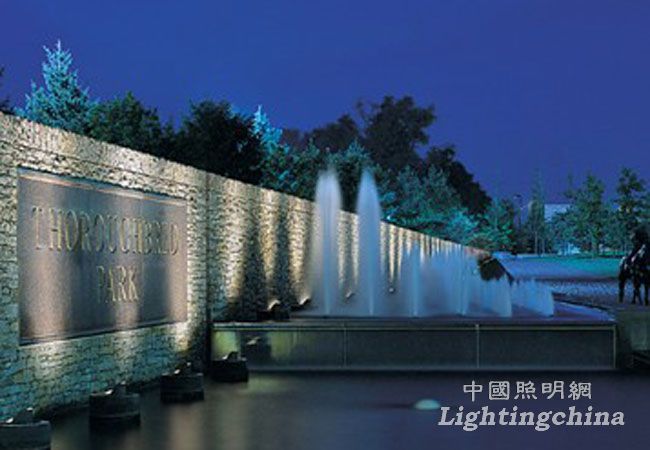
Figure-3: Garden Lights
3. City lighting has brought many influences on people's lives.
On the one hand, urban lighting has brought positive impacts on people's lives, arousing people's yearning for a better life, improving people's aesthetic taste and adding vitality to the city. At the same time, it also brings a series of negative effects such as energy waste, light pollution, and damage to the appearance of the building. And we are addressing these negative effects, expanding its positive impact, and promoting the healthy development of urban lighting.
4. People's recognition of urban lighting is both diverse and popular.
The perception of "beauty" was originally a category of ideology. People of different eras, different nationalities, and different cultural backgrounds have different approvals for beauty (Figure-4: Hainan's beautiful crown of Asian beauty pageant lighting). Therefore, the light is appreciated by the public as a landscape, and there are also different kinds of identity. The benevolent sees benevolence, and the wise sees wisdom. However, lighting has a different public cognition than other art, that is, people are easy to accept "bright things" and then accept "bright and beautiful" things. And the general public is very easy to accept color lighting, dynamic lighting, lighting with lighting, and so on. This is the intuitiveness of the light to give people the most direct beauty experience.
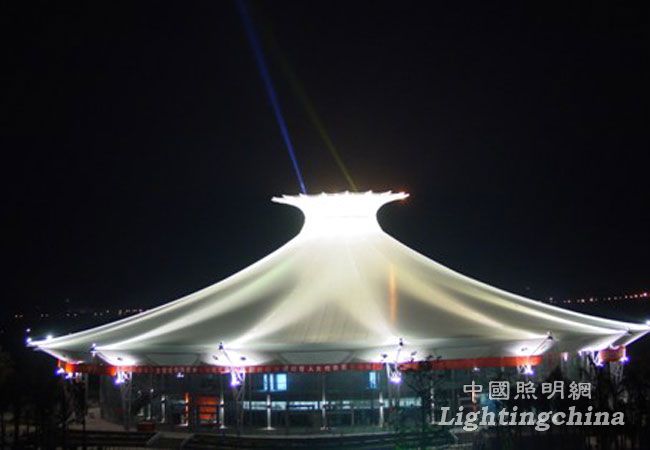
Figure-4: Hainan Beautiful Crown Asian Beauty Pageant Lighting
two. The four principles of urban lighting design
1. The development of lighting landscape should be in harmony with the development of urban landscape
The current development of urban landscape is developing in the direction of “nature, order and interactionâ€. As part of the urban landscape, the lighting landscape should also have its own naturalness, orderliness and interactivity, so as to be in sync with the overall development of the city. The natural nature of the lighting landscape should be reflected in the understanding of the building and the objects, and the recognition of the building environment, and the perfect combination of architecture and lighting with a reasonable expression. The order of the lighting landscape should be reflected in the rational design and planning, establish a light order, achieve the balance of light, create nighttime beauty through contrast, color, change, and rhythm (Figure-5: Shanghai Science and Technology Museum lighting ), using the language of light to express the artistic conception of the landscape. For example, the contrast of light is used to express the scale of the building, the rhythm and rhythm are used to express the details of the building, and the color and change are used to express vitality and vitality.

Figure-5: Shanghai Science and Technology Museum Lighting
If we use our urban lighting landscape as a work of art, the naturalness is to establish an understanding and expression of architecture and urban content (Figure-6: Huangyan City Government Office Building in Taizhou). Order is the establishment of a system of understanding of its spiritual content. 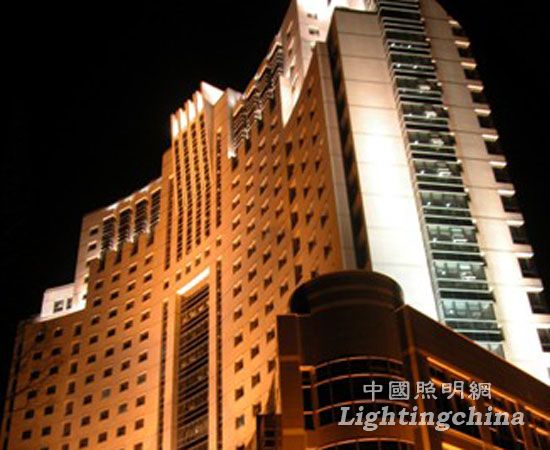
Figure-6: Office Building of Huangyan City Government, Taizhou
The interaction of lighting landscape is reflected in the understanding of people's lives. People in different living areas have different requirements for lighting, and development also brings about changes in people's demand for lighting. For example, when we design in small cities and suburban counties, we find that customers there are more likely to accept strong lighting effects, while cities in the city prefer soft and calm lighting. Another example: In the past, designing lighting in Shanghai, we are easy to accept natural yellow and white light, and we are cautious about the use of color light. Now with the development of society, the pace of life is accelerating, people like to be bright, like colorful, to make themselves more relaxed environment, color and changing lights are recognized by the public. Therefore, the interaction between the lighting landscape and the needs of people affects the design of the lighting system.
2. The performance of urban lighting landscape should be in harmony with the connotation of regional culture
Any landscape art has its own cultural expression. The characteristics of Chinese culture are ethics and morality. It is stable, subtle, talks about introversion, and advocates connotation. With the reform and opening up these years, China has accepted the influence of Western culture, especially Shanghai and coastal cities, forming a blend of Chinese and Western cultures, which has formed cultural differences in different regions. Cultural differences lead to differences in the recognition of the lighting landscape. Therefore, different cities have different requirements for the landscape, which requires us to express in different ways, so that the lighting performance is in harmony with the regional culture (Figure-7: Zhejiang Wuzhen Phase II Lighting). This is also a cultural element worth considering in our design.
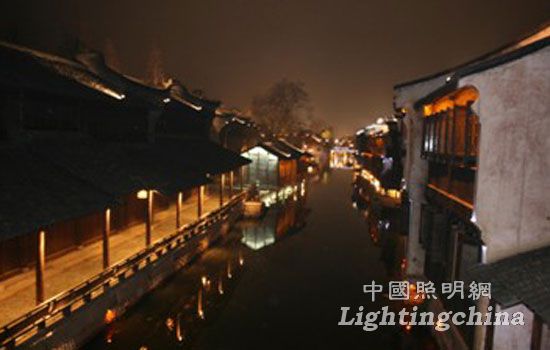
Figure-7: Zhejiang Wuzhen Phase II Lighting
3. City lighting should be in harmony with people's visual psychological feelings
The light gives people a beautiful experience, indicating that the light environment has an important impact on people's psychological feelings. When designing the second phase of the Shanghai Science and Technology Museum, we conducted a questionnaire survey and field illuminance measurement for the first phase of the lighting. The main purpose was to understand the evaluation of the light environment brightness of different exhibition areas of the Shanghai Science and Technology Museum, different colors and different colors. The preference for lighting forms. The 300 visitors who were interviewed were divided into five age groups, namely, under 10 years old, 10-20 years old, 20-30 years old, 30-40, 40 years old or older, and the three-level evaluation method for light environment brightness was used. Dark, moderate and bright; the color of the light uses the blue, yellow and white mainly used in the exhibition hall. At the same time, it also adds the color of the light that the tourists want, and puts it in the "other" category; the lighting form is according to the exhibition hall. The forms that have been adopted fall into three categories, namely dynamic lighting, color-changing lighting, and static lighting. During the survey, according to the questions that have been set, the visitors will be selected to answer, based on the age, the survey results will be expressed as a percentage of the total number of people in a certain category, and the statistical software will be used to generate a percentage scale chart. -8, Figure-9, Figure-10, which serves as the basis for the analysis.
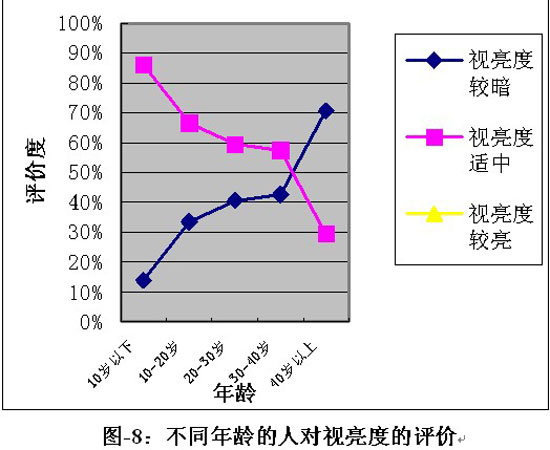
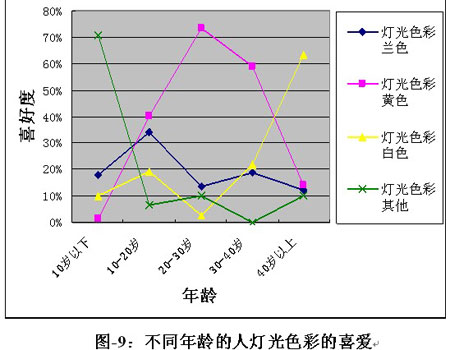
As a result, we found that children under the age of 10 liked the bright, warm-toned lighting. The 10-30 year olds had no significant difference in the preference for yellow and white lights, while those over the age of 50 preferred white light more than yellow. People of different ages have a greater difference in the psychological perception of the color of light in the light environment. Children and primary and secondary school students like bright colors, such as purple and orange, they feel very excited in this environment, and they have low affinity for blue and yellow. Young people have cool colors such as blue. I like it more, they are more rational. Middle-aged people prefer warm colors, and they think that yellow can relax very well. The survey shows that almost no children under the age of 10 like static and bright lights. They prefer lights with color change. Among them, 30-40 years old have a preference for static bright lights higher than those aged 10-30; 40 years old or older People almost don't like colored lights and dynamic changes. Through investigation and analysis, we applied the results to the second phase of the Shanghai Science and Technology Museum, and achieved satisfactory results (Figure-10, Figure-11, Figure-12: Shanghai Science and Technology Museum Phase II exhibition area lighting). It can be seen that fully considering the influence of the elements of lighting design on people's visual psychology, and understanding the psychological hints of light color can help us grasp the general direction of design. Simply pursuing dynamic effects, completely abandoning color lighting or abusing color lighting can make us in trouble.
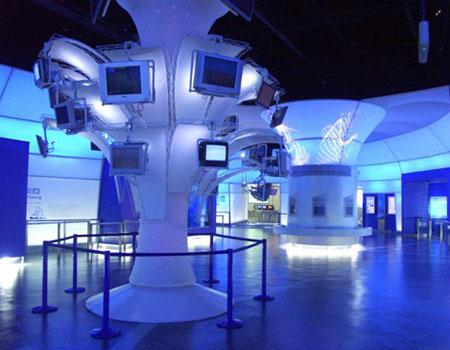
Figure-10: Science and Technology Museum Phase II Pavilion - Information World 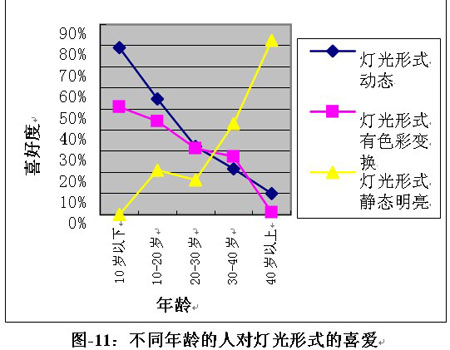
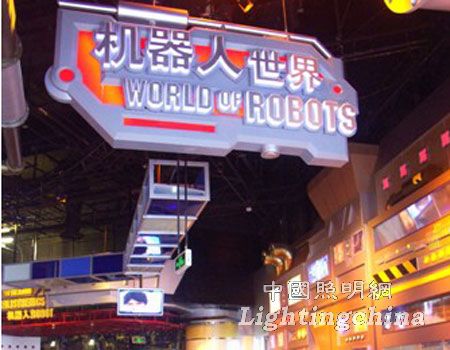
Figure-12: Lighting of the second phase of the Shanghai Science and Technology Museum 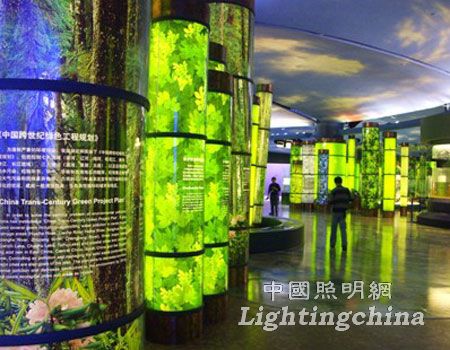
Figure-13: Shanghai Science and Technology Museum Phase II Earth Home
4. Let the development of urban lighting be in harmony with the development of science and technology
The development of computer technology and network technology has brought great changes to people's lives. Modern lighting technology should be based on computer technology, and play the advanced nature of science and technology in the whole process of design and debugging, and push the development of lighting technology to a new one. starting point. Such as the application of networked control systems (Figure-14: Intelligent Lighting Control System), intelligent lighting applications, advanced sensor components, etc., will make the lighting to multi-function, controllable, adjustable, programmable, etc. Humanized and personalized lighting system development.
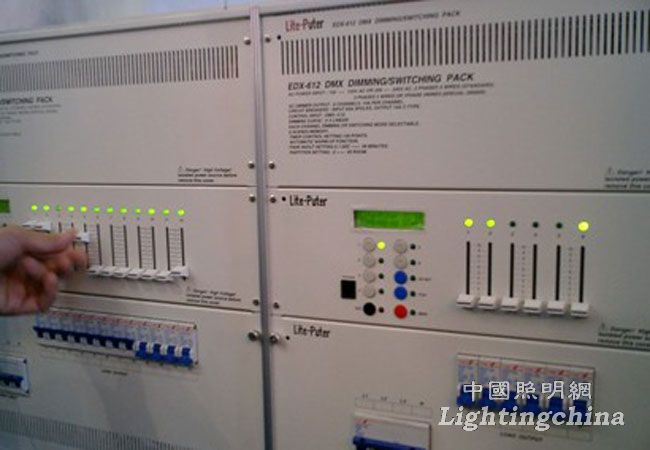
Figure-14: Intelligent Lighting Control System
3. Future city lights make life better
We look forward to the future of urban lighting is colorful, full of vitality, so that the beauty of urban lighting will always remain in people's hearts, blending into people's lives, but also bring the melody and meaning of light to the city's life and hope.
references:
1. Zhu Hong, Luo Hong. On the Factors Affecting the Light Environment in Modern Exhibition Halls, Journal of Lighting Engineering 03, 2005
2. [English] Roger Scruton. Architectural Aesthetics, China Building Industry Press
3. Wang Hongcheng, Lv Chen, Landscape Design Elements, Tianjin University Press
Led Corn Light E27,Led Light,Led Lamp
Thefirst International Lighting Co., Ltd. , http://www.gddivinglight.com